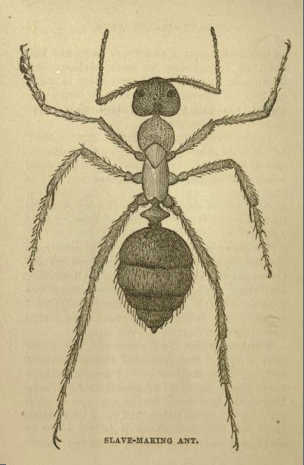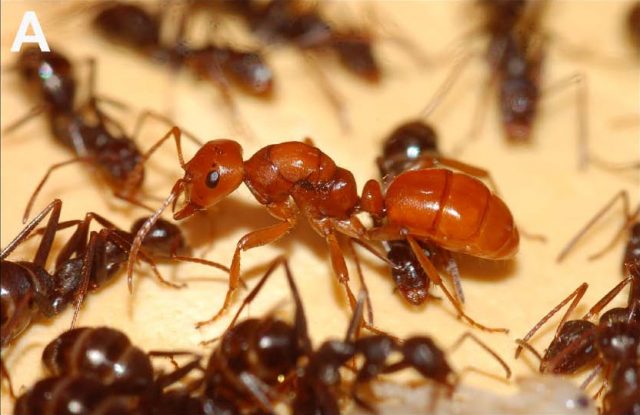Chemical warfare and slave-maker ants

Brood parasites are organisms that rely on others to raise their young. The strategy appears among fishes, birds and insects, including some species of ants. Slave-making ants capture brood from other ant species to increase the worker force of their colony through regular, destructive raids that frequently finish with the killing of many workers and the queen of the attacked nest. As a consequence, few colonies survive a slave-maker raid. After emerging in the slave-maker nest, slave workers work as if they were in their own colony, assuming most tasks in their new nest while parasite workers only concentrate on replenishing the labor force from neighboring host nests. The slave-makers may either be permanent social parasites (thus depending on enslaved ants throughout their whole lives) or facultative slave-makers, that use slaves as a temporal advantage. The behavior is unusual among ants but has evolved several times independently. Most slave-raiders capture only brood, but a few species also enslave adult workers. There are sometimes slave-maker nests with two species of slaves. For example, the slave-maker P americanus can have slaves of T. longispinosus and T curvispinosus at the same time.

Slave raids are preceded by a scouting event during which a single slave-maker worker discovers and inspects a host nest and returns to its colony to recruit nest mates and prepare the raid. On their hand, nests under the risk of an attack have different strategies to avoid it or to survive. One is to watch for scout ants from the slavemaking species and kill them (search and destroy!) before they can inform to their mates that a possible host nest is available. The second strategy is to fight and frequently hosts defend fiercely their brood and their nest in deadly battles. A third possible defense system is to flight, abandon the nest site, save a fraction of the brood and the queen, and look for a new start in a different place.
All three defense strategies have a cost for slave-making ants and then, some species have evolved a different approach: avoid host recognition and do the kidnapping of slaves unnoticed1. A common strategy is a chemical mimicry, where social parasites actively synthesize substances to mimic the hosts’ chemical signature. A drawback of this procedure is that the parasite’s success is restricted to a single host species, the one whose profile is imitating. Chemical camouflage is more flexible and more common. In this strategy, the slave-maker ants acquire the host’s odor through rubbing, allogrooming, or trophallaxis or from nest material. The disadvantage here is the danger of the first contact when the parasite has had no time to acquire host chemicals and can be therefore detected and killed. A third strategy, also commonly used, is chemical manipulation, where parasites employ offensive chemicals to disrupt the host defense systems. After entering into the host nest, the social parasites release substances from their glands which serve as manipulative alarm signals, as chemical weapons, and as appeasement substances, creating a chemical disruption of the host nest normal life.
The last stratagem is named chemical insignificance and is a rare strategy where the parasite lacks recognition cues on its cuticle. Host ants facing these chemically «invisible» parasites will not recognize them as foreigners and unintentionally integrate them into their colony. It is rare because those hydrocarbons involved in recognition also function as desiccation barriers and thus these ants risk to die from dehydration. The advantage is that hosts will not recognize the chemically invisible parasites and will integrate them into their colony where they can get as much brood as they want.
Slave-maker species such as Temnothorax pilagens employs two different strategies:
Peaceful raids: Neither the slave-maker, not its two hosts show aggression. The slave-maker ants steal the host brood unmolested and, besides, they carry the adult host workers into their own nest and integrate them into its slave workforce.
Escalated raids: The slave-maker ants switch their behavior and sting most adult hosts to death. Presumably, the escalated raid is a peaceful raid that went wrong, maybe because the host ants recognized and attacked the social parasite, which will be counteracted by a killing spree from the invaders. The first option is clearly better since in the escalated raids, the slave-maker group loses some ants and they cannot exploit adult hosts as slaves. In fact, results are much worse, integrating a tenth of the hosts integrated during a peaceful raid (including brood and adult workers).
In some species, the invader is a young queen. Queens of the European slave-maker Myrmoxenus ravouxi invade host colonies and gain acceptance from adult host workers over the duration of a few weeks whereas slave-maker workers get detected and attacked during raids. In addition, host queen absence facilitates adult workers slavery by two possible mechanisms: changes in the chemical profile of the colony or lower worker aggression. A reduction in worker aggression following queen death is a common phenomenon in ants and has been attributed to the lack of the queen’s primer pheromone 2.
For those who feel pity for the host slaved ants, there is a currently discovered defense trait, the so-called slave rebellion 3. Slaves selectively kill the pupae of Protomognathus americanus thereby reducing the colony growth. Indeed, both very small slave-maker colonies and extremely large colonies were found in the field. It is possible that the slave rebellion trait is therefore not expressed in large colonies or the slave-maker is better adapted against this defense trait in these nests. In addition, since enslaved workers do not reproduce, they obtain no direct benefit from this rebellion behavior. However, there may be an indirect benefit: neighboring host nest that are related to rebels can benefit from a reduced raiding pressure, as a result of the reduction in parasite nest size due to the enslaved workers’ killing behavior.
References
- Kleeberg I, Foitzik S (2015) The placid slavemaker: avoiding detection and conflict as an alternative, peaceful raiding strategy. Behav Ecol Sociobiol DOI: 10.1007/s00265-015-2018-6 ↩
- Vander Meer RK, Alonso LE (2002) Queen primer pheromone affects conspecific fire ant (Solenopsis invicta) aggression. Behav Ecol Sociobiol 51: 122–130. ↩
- Pamminger T, Foitzik S, Metzler D, Pennings PS Oh sister, where art thou? Spatial population structure and the evolution of an altruistic defence trait. http://arxiv.org/pdf/1212.0790.pdf ↩